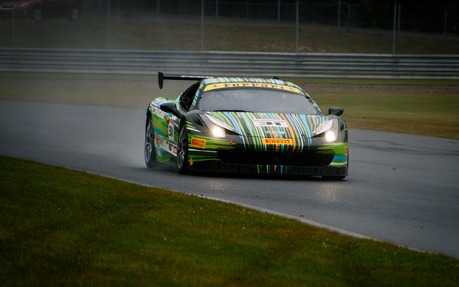Ferrari Challenge: If I Were Rich Man
At this year’s Montréal Grand Prix, Formula 1 cars didn’t only share the track with the little Nissan Micras, which we covered in a previous article, but with some other intriguing cars as well.
Those cars were Ferrari 458s modified for the track. Three months later, I had the pleasure of attending the Ferrari Challenge event, where just setting foot in this universe of racing, power and refinement was simply fascinating.
The 458 Evo
The Ferrari Challenge Series is strangely reminiscent of the Nissan Micra Cup, but with much higher costs.
First off, the cars are all essentially the factory-standard Ferrari 458 Italia. Under its positively beautiful body, it has the same mechanical components as the road version, namely an Italian 4.5-litre V8 developing 567 horsepower at 9,000 rpm. Power is directed to the rear wheels using a seven-speed dual-clutch semi-automatic transmission. Note that this transmission shares the same roots as the one found in the Mercedes SLS AMG.
The most important parts of the car are also unchanged. It has the same ceramic brakes as the regular version, the same steering and the same electronic system dedicated to preventing drivers from finishing the race in the grass at the edge of the track.
These 458s, however, are prepared by participating dealerships and include the Evo package, which makes them illegal for road use. This package includes slicks (or rain performance tires), firmer shocks and a bunch of aerodynamic improvements, such as a massive spoiler. Unfortunately, the small fins found at the front of the street legal version of the car have to be removed, because body features that change shape under air pressure are not allowed in motorsport.
The car’s passenger compartment has been stripped to the bare necessities, and there’s a safety cage that guarantees driver safety.
Within the next two years, the new Ferrari 488 GTB, with its 661 horsepower and bi-turbo engine, should replace the 458 in this Series and help make the spectacle all the more impressive.
The gentleman driver and the car on the track
The series is made up of wealthy, amateur drivers who have invested considerable sums to acquire a 458 from a participating dealership, have it modified, pay the registration fees for the events and mobilize a team of engineers with the car to the various races of the season, which can take place anywhere in North America. Drivers are free to seek sponsorships if they so desire.
Fortunately, they can rely on unconditional support from Ferrari, which makes its presence felt at all of the races with a team of specialists and spare parts and tires on hand for any necessary (and costly) repairs. The participating dealerships are also very generous, usually providing the team and the transportation. But everything is negotiable.
What about the drivers? To keep the competition friendly, the series doesn’t want to lure professional drivers, especially since there’s no prize money for winners. However, if you want to participate, you need a certain level of skill, usually ensured by taking a few driving lessons.
How does this virtually factory-standard Ferrari handle on the track? Just adding slicks makes a huge difference, while the improved aerodynamics and suspension help the car handle more lateral force through corners.
After completing a few laps in the passenger seat, I can objectively say that there’s a difference, if only for the speed at which this 458 Evo corners. The fact that the factory-standard mechanics can withstand the stress of a race proves that Ferrari doesn’t just build eye-candy.
In conclusion, they put on a good show, and a melodic one, since Italian engines still lead the pack when it comes to sound. Ah, if only I were a rich man!
- Visit our Ferrari zone
